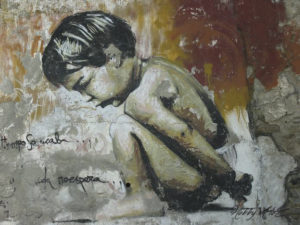Introduction to Graffiti
How do you feel about graffiti? Is it a destructive form of vandalism that should be scrubbed from walls immediately? Or is it an expressive, modern form of art? That’s the big debate! Famous figures like Banksy have shaken things up by addressing social and political issues with his graffiti, that you can find splattered in obscure places all over the world.
This introduction to graffiti is for any newbie thinking of picking up a can of spray paint. Let’s take a look at the progression of graffiti history and how you can become the next Banksy!
The Short Version of Graffiti History
Modern graffiti is just a baby in terms of the art world! It has been around for less than half a century but has captured the attention of young and old people alike. Although, ancient Greeks and Egyptians would often carve language into caves and walls.
Now, graffiti is stamped on walls in almost every city around the world and in many, is a big part of the culture.
1967
A high school student in Philadelphia began writing on walls around the city to grab the attention of a girl!
1970’s
People began to sprawl their name or “tags” over buildings. These people were often part of street gangs and they wanted to get their names known or mark their territory.
1980’s
Graffiti began to be recognised as an art and galleries began to showcase the work of graffiti articles. Graffiti had become controversial and the mayor of New York, John Lindsay, declared that he would not tolerate the public displays of art. (Or vandalism, however you see it.)
Now
Graffiti history is still in its early stages, and we can expect to see a bloom in the bold, bright artwork on bricks down alleyways and on the sides of restaurants. Many artists are now using graffiti to depict famous celebrities or world events and give their angle on the topic. With the rise of social media, tourists flock to famous graffiti spots to get a photo next to it.
Graffiti Introduction and Tutorial for Beginners
This graffiti introduction is for the complete beginner. Ideally, you will have a natural flair for art and enjoy creating unique pieces and words. You don’t always have to tarnish pubic property to be a graffiti artist! You can create graffiti words on large pieces of paper or stickers. It’s all about your style and your message. So, where can you begin?
- Choose a name. Choose your name or “tag”. You will be writing this down many times, so go with a name that looks aesthetically cool and that you enjoy scrawling.
- Buy a sketchbook. Buy a sketchbook and let it become your best friend. Take it everywhere with you and practise lettering and images, or whatever it is you want to create.
- Network or take a class. This is a close-knit subculture and you can get tips from those that have been doing it for a while. You can get tips on the best way to develop your style or lettering, whether this is online or in a class. However, always be unique. If you steal what someone else is doing, you’ll be branded a “toy” in the graffiti world. If you aspire to make a name for yourself, you have to bring something new to the table.
- Buy some permanent markers. Start off small with bubble writing. Use markers to try tagging your new name. Build your way up as your confidence and your ability improves.
Benefits of Graffiti
Freely express yourself
Art has no limits. You can create whatever is in your mind, whether that is trivial, funny images or something that challenges social norms and confronts your deepest fear. Your mural is your chance to express your thoughts, stamp your name and create a buzz around your art.
Graffiti has been a powerful medium for youths to feel a part of their society and show their own roots in the community.
Benefit the city
Graffiti art in some cities can be a huge tourist trap. Often, laneways in cool, hidden parts of a city will showcase colourful art from a selection of graffiti artists. This brings tourists and is great for the economy.
As well as being financially beneficial, it also makes your city bright and unique. Graffiti transforms otherwise grey buildings and train stations into something thought-provoking and beautiful. Graffiti can be a telling sign that the city you’re in is filled with an interesting urban culture full of artistic inhabitants. Cities like London, New York and Melbourne are praise for their street art, rather than the lesser enjoyed “tagging”.
Graffiti is a form of art
Once you manage to pull some graffiti off of a wall, you can sell it! It’s possibly one of the most modern art forms and can sometimes sell for mega bucks. If you’d like to line your pockets a little more with this hobby, I’ll talk about how you can do that later on.
The other great thing is that graffiti is an avenue to bring art to the public, and especially to young people. Lots of individuals don’t enjoy the formal settings of an art gallery and so they otherwise wouldn’t get to experience much art.
Making Money from your Hobby
Some of the work by Banksy has sold for over £100,000! He’s the most iconic and influential figure in the industry, but you too can make some extra cash by taking up graffiti. You can’t jump straight into the hobby and monetise from it straight away. It requires lots of experience and a well-honed skill. Once you have that, you can start thinking about money-making methods.
- Build your reputation. If you want sales to come to you, it’s all about networking and building a good reputation within the sub-culture. Word-of-mouth is crucial to your career, so if you’re known for being original and creative, you shouldn’t have a problem with making sale or getting paid work.
- Create a client base. You can advertise your work and receive contracts from big and small companies. This could be anything from a clothing brand to a large music label, and you’ll probably receive commissions for your work. Otherwise, work on some dedicated graffiti areas or big city projects.
- Sell your pieces. Many graffiti artists create work at home or in their studio and use paper instead of buildings to paint on. If you choose this method, you can set out to sell your work to galleries and any other business that might be looking to buy and showcase your art.
“Art should comfort the disturbed and disturb the comfortable.” — Banksy
I hope this graffiti introduction has shown you how you can practise art without being “safe”. If you do decide to take up graffiti, try to respect boundaries. There are many cities around the world that have legal spots and alleyways dedicated to graffiti art. Defacing some public buildings is illegal. Always bear in mind where you are, but aside from that, let your mind and your art run wild!
References : http://www.pbs.org/newshour/art/the-history-of-american-graffiti-from-subway-car-to-gallery/





